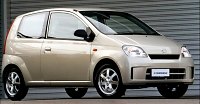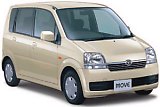|
Daihatsu Mira / Charade
Debut: 2002
Maker: Daihatsu
Predecessor: Cuore / Move (1998)
|
|
 This
generation Mira was born in late 2002 in Japan. As before, it falls
within
the scope of K-cars thus it is primarily designed for the Japanese
market.
However, it is also sold in European and Australian market as Charade,
taking advantage of the more recognizable name to overseas buyers.
There
is no big difference between the Japanese and overseas version except
that
the latter has a 1.0-litre engine while the former is limited to
0.66-litre
due to the K-car regulation. This
generation Mira was born in late 2002 in Japan. As before, it falls
within
the scope of K-cars thus it is primarily designed for the Japanese
market.
However, it is also sold in European and Australian market as Charade,
taking advantage of the more recognizable name to overseas buyers.
There
is no big difference between the Japanese and overseas version except
that
the latter has a 1.0-litre engine while the former is limited to
0.66-litre
due to the K-car regulation.
We
used to have
little knowledge
about K-cars because of language barrier. Thanks to the availability in
European market, we can understand how Mira / Charade compare with
other
cars in the world. If Mira / Charade wants to be respected, if Daihatsu
really worth the reputation of "Small Car Expert", then the car must
beat
its competitors in the price range, namely, Hyundai Getz, Daewoo Matiz,
Fiat Seicento and Seat Arosa. What about Ford Ka, VW Lupo, Skoda Fabia
and Daewoo Kalos etc.? they are considerably more expensive than the
little
Daihatsu thus are out of the scope.
In terms of
packaging efficiency,
no one can match the Japanese. 2 decades of K-cars experience teach
them
how to squeeze maximum passenger room out of limited exterior size.
However,
even compare with other K-cars, the Mira / Charade (and its sister car
Move) is still the King of space efficiency. All K-cars are no more
than
1475mm wide, but the little Daihatsu manages to make the doors so thin
(and still complies with safety reg) that the cabin width measures
1300mm.
All K-cars are no longer than 3400mm, but again the Mira has the
longest
wheelbase at 2390mm. That’s longer than many cars a class above,
including
Toyota Yaris and Daihatsu’s own Sirion. This makes Arosa’s 2320mm shame
and Seicento’s 2200mm laughable. Only Hyundai Getz - which actually
belongs
to a larger class but equipped with a cheap and underpowered 1.1 engine
- offers more cabin space.
In real world,
such dimensions
translate to a cabin that sits 4 people in comfort, with vast of
legroom
and shoulder room front and rear. On the other hand, the tall roof
enables
abundance of headroom for even the tallest people. Seating position is
as high as any modern city cars. The dashboard is simple and easy to
use.
You will neither describe it as stylish nor elegant, but build quality
is surprisingly high for this price - the dashboard is made of decent
plastic
and is well screwed together. Fabric and trimming are also very good
for
the class.
Predictably,
the
Mira chassis
is not designed for keen drivers - it rolls heavily if rush into
corners
because it is not equipped with anti-roll bars. It runs into understeer
early. Its speed-sensitive electric power steering provides artificial
feel. However, the car is easy to drive at speed most people concern.
Furthermore,
the ride is supple for a car so small, thanks to soft suspension setup
and long travel, also fine choice of damping. It copes easily with
bumpy
roads. To mini car buyers, comfortable ride is certainly more important
than cornering ability.
It also does
very
well in
motorway cruising, thanks to the use of tall gearing and an engine that
is surprisingly refined and quiet at high rev. The engine on offer in
Europe
is a 1.0-litre 3-cylinder engine similar to Sirion’s. With twin-cam 12
valves and variable valve timing, it delivers useful torque across the
rev, although maximum power of 58hp is unremarkable. Because the car
weighs
just 720kg, it accelerates to 60mph in just 12 seconds, easily leading
the class. The Japanese Mira uses a similar 659cc triple, also with
VVT,
so we can expect similar refinement, if not similar performance.
Anyway,
for those who need more power, Daihatsu also offers a turbocharged
version.
The biggest
weapon is still
price. A fully-equipped Charade is sold at the same price as the
cheapest
Seat Arosa. This could be another Bargain of the Century. For a car so
pretty, so well-built, so roomy and so comfortable, it could ask for
much
more. Now Daihatsu has a winning car. |
| The
above report was last updated on 14 Jun
2003. All Rights Reserved. |
Move
|
 How
to describe Move? basically, it is a roomier and more versatile version
of the Mira. Both cars share the same floorpan and even up to all
essential
dimensions excluding height, which the Move is 130mm taller than Mira.
To most people, the extra headroom is meaningless because Mira is
already
a very tall car. However, the even higher roof does enhance the feel of
roominess even though it is rarely put in use. How
to describe Move? basically, it is a roomier and more versatile version
of the Mira. Both cars share the same floorpan and even up to all
essential
dimensions excluding height, which the Move is 130mm taller than Mira.
To most people, the extra headroom is meaningless because Mira is
already
a very tall car. However, the even higher roof does enhance the feel of
roominess even though it is rarely put in use.
Like a
mini-MPV,
the Move
offers quite a lot of versatility: the rear seat can slide back and
forth
by 250mm to alter the distribution of passenger room and luggage room -
just like Toyota Yaris; the front and rear seat can be converted into a
pair of bed; there are also much more storage space, cup holders and
coat
hooks throughout the cabin. Moreover, the steering-mounted gear lever
enables
front seat lateral walk-through. Like the Move, the rear seat is 50-50
split and can fold down to become cargo loading area.
As
it has higher
center of
gravity and carries around 100kg more weight than the equivalent Mira,
Move copes with corners even worse and goes slower in straight line.
Therefore,
unless you need those extra versatility, Mira is definitely a better
bet.
It is cheaper to buy and more economical to run too.
 The
top Move RS (see picture at the left) is powered by a 4-cylinder
turbocharged
and intercooled engine instead of the Mira’s 3-cylinder. Despite of an
extra cylinder, it delivers the same 64 horsepower and even slightly
less
torque. Power band is narrow thus unsuitable to the compulsory 4-speed
automatic transmission. It has a sporty exterior design including big
air
dam and a pair of stylish headlights. Sporty suspensions tuning - with
the ride height lowered by 20mm - limit body roll pretty effectively.
However,
it is still a disappointing car - slow, uninvolving, understeer a lot
when
the turbo is ON, harsh ride, a lot of suspension noise and engine noise. The
top Move RS (see picture at the left) is powered by a 4-cylinder
turbocharged
and intercooled engine instead of the Mira’s 3-cylinder. Despite of an
extra cylinder, it delivers the same 64 horsepower and even slightly
less
torque. Power band is narrow thus unsuitable to the compulsory 4-speed
automatic transmission. It has a sporty exterior design including big
air
dam and a pair of stylish headlights. Sporty suspensions tuning - with
the ride height lowered by 20mm - limit body roll pretty effectively.
However,
it is still a disappointing car - slow, uninvolving, understeer a lot
when
the turbo is ON, harsh ride, a lot of suspension noise and engine noise. |
| The
above report was last updated on 15 Jun
2003. All Rights Reserved. |
Max
|
 Space
is always the first priority for developing K-cars. Daihatsu Move has
vast
of space, but it is considered too tall for the arising popular tower
parking
in Japan’s cities. This is the primary reason of developing the Max. At
1550mm, Max is the tallest allowed by tower parking. That make it
between
Move and Cuore. However, to maximize space (the name Max means exactly
this), Max has stretched wheelbase slightly and gets 35mm more interior
length than the previous generation Move on which it is based. By
thinning
the doors, it gets another 55mm interior width to free shoulder room.
The
otherwise mechanicals are the same as Move, including suspensions,
engines
and transmission, so we are not going to discuss here. Space
is always the first priority for developing K-cars. Daihatsu Move has
vast
of space, but it is considered too tall for the arising popular tower
parking
in Japan’s cities. This is the primary reason of developing the Max. At
1550mm, Max is the tallest allowed by tower parking. That make it
between
Move and Cuore. However, to maximize space (the name Max means exactly
this), Max has stretched wheelbase slightly and gets 35mm more interior
length than the previous generation Move on which it is based. By
thinning
the doors, it gets another 55mm interior width to free shoulder room.
The
otherwise mechanicals are the same as Move, including suspensions,
engines
and transmission, so we are not going to discuss here. |
| The
above report was last updated on 25 Nov
2001. All Rights Reserved. |
Kei-car
|
In Japan,
a category
calls K-Car
was established since the mid-80s. Cars with dimensions fall within
3300mm
of length and 1395mm of width, with engine capacity not exceeding
660c.c.
(original regulation was 550c.c.) and max. output not exceeding 64 hp
will
be benefited by lower tax. Nearly all car makers build such cars
because
they suit big city like Toyko very well - easy parking, need not to be
fast because of traffic jam.
Based
on this
dimension,
most K-cars use space efficiently by locating the wheels right at the
corners,
then extend the height which is not restricted by the regulation. Power
all come from 4-valves engine, some even with turbocharger and
intercooler
to compensate the lack of capacity. The main selling point is price and
running cost, but fun factor is also important. Recent K-Cars usually
offer
Recreation Vechicle-like cabin layout flexiblility plus a lot of
storage
space and funny styling. Most customers are young people.
In
recent years,
K-Car sales
boomed because of economic depression. Suzuki Wagon R and Daihatsu Move
both ever topped the domestic sales chart, beating the mighty Toyota
Corolla.
Since 1999, the regulation was loosen further to 3400mm length and
1475mm
width, hopefully K-Car will be more popular. |
| The
above report was last updated on 17 Feb 99. All
Rights Reserved. |
|
|